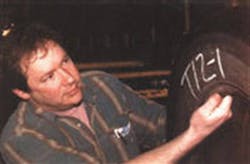Diminishing returns: LT tire retreaders profit, but feel the price squeeze
Light truck tire retreading has been a consistent profit source for Sehman's Tire Service Inc. since the Franklin, Pa.-based company first opened its doors in 1957. But market dynamics are changing, according to company President Larry Sehman (pictured) -- and the era of highly profitable light truck tire retreading may be on the way out. "The segment is shrinking."
Sehman's has a 6,000-square-foot retread shop with the capacity to produce 35 light truck retreads a day. But more often than not it only completes 35 a week. Sehman blames dropping demand for light truck tire retreads on the growing proliferation of sport utility vehicle/pick-up truck-ready P-metric passenger tires. "More P-metric tires are coming out on light trucks at the original equipment level because people aren't using trucks as trucks -- they're cars, basically.
"Now you have P225/75R16 standard load, P225/75R16 extra load, P225/75R16 in load ranges C, D and E -- just about all sizes in the 75-series are available in P-metric. It's getting more confusing determining what is a true light truck tire."
Other long-time light truck tire retreaders say pricing has become a critical issue. Bray's Recapping Inc. in Mount Airy, N.C., produces 20 units a day, a 50% decrease from one year ago. "Margins are shrinking because of some lower-priced imports coming in," says President Dean Bray.
Domestically produced new light truck tire prices also are dropping. The average retail price last year for a major brand LT235/85R16 light truck unit was $117.03, compared to $119.99 in 1999, according to Modern Tire Dealer statistics.
Bray expects the price difference between new tires and retreads to shrink further. "We're probably at a 20% difference right now."
Seattle, Wash.-based Phelps Tire Inc.'s daily light truck retread count has dropped to an all-time low of eight a day, according to sales representative Hal Nendick. "You can buy a new light truck tire as cheap as you can buy a retread."
The trend will continue "until consumers find out that buying 'cheapie' new light truck tires isn't the way to go." But Nendick admits that's a hard sell from a retreader's standpoint. Customers usually have to experience low-quality tire failures personally before turning to retreads as viable alternatives, he says.
Similar price squeezes have made passenger tire retreading virtually obsolete. Ray Carr Tires Inc. in Harrisonburg, Va., exited the segment three years ago because it had become uneconomical. Light truck tire retreading should stay profitable, says President Ray Carr Jr., "if the rubber companies raise prices." Meanwhile, Carr is moving his light truck tire retreading operations into his medium commercial truck tire retreading facility to cut down on overhead expenses.
McCarthy Tire Service Inc. in Wilkes Barre, Pa., isn't feeling the price squeeze between retreads and new tires. "There's a good $20 to $25 discrepancy between the two if you buy a good, quality tire," says Vice President Neil Horn. Most major fleets run premium-level tires, he says.
McCarthy's most popular light truck retread sizes include 225/75R16, 235/85R16 and 245/75R16. "There's still a decent market for light truck tire retreads."
Sidney McDowell, president of Retreads Unlimited in Anderson, S.C., says falling new tire prices "will eventually bottom out and go up. There will be a point where they just can't cut anymore."
McDowell emphatically refuses to drop light truck retread prices. "We sell every one we make so there's no need (to do it)."
The dealer's only complaint about the segment is that casing quality is decreasing. "We're seeing a bigger failure rate when we buff the tires down." Tires with cuts or separations are immediately junked, he says. "Some of these tires are unretreadable when they wear down."
The problem results from tiremakers cutting costs, according to McDowell. "But that's out of our hands."
Light truck tire retreading is trending downward. Between 1996 and 2000, the number of light truck tire retreads produced decreased by 19%, from 7.1 million units to 5.75 million units, according to MTDDespite gloomy forecasts, there always will be demand for retreaded light truck tires, says Nendick. "We still have a lot of customers who prefer retreads," especially larger fleets looking for greater cost efficiencies. His company has no plans to change how it markets the items.
To stay competitive, Bray has lowered light truck retread prices for certain high-volume customers. "But we try to maintain our prices," he says. "You can't lower prices too much because expenses like fuel and energy, plus employee wages, are going up."
McDowell is considering expanding his company's capacity to include 17-, 18- and 19-inch light truck tire retreads; his current retread diameters top out at 16 inches. "We have another three years before we have to make a decision on it."
And Sehman plans to keep plugging away, as certain sizes, like LT235/85R16, remain profitable. "You're talking a minimum of about $75 for a new one, and I can sell a same-size retread for around $55, so that's still a good tire." The biggest challenge will be keeping up with new OE sizes, he says.
